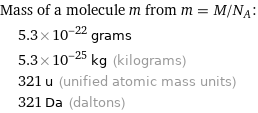Input interpretation

hexaamminenickel(II) bromide | molar mass
Result
![Find the molar mass, M, for hexaamminenickel(II) bromide: M = sum _iN_im_i Plan: • Write the chemical formula and gather atomic masses from the periodic table. • Determine values for N_i and m_i using these items. • Finally, compute the mass. Write the chemical formula: [Ni(NH_3)_6]Br_2 Use the chemical formula, [Ni(NH_3)_6]Br_2, to count the number of atoms, N_i, for each element: | N_i Br (bromine) | 2 H (hydrogen) | 18 N (nitrogen) | 6 Ni (nickel) | 1 Look up the atomic mass, m_i, in g·mol^(-1) for each element in the periodic table: | N_i | m_i/g·mol^(-1) Br (bromine) | 2 | 79.904 H (hydrogen) | 18 | 1.008 N (nitrogen) | 6 | 14.007 Ni (nickel) | 1 | 58.6934 Multiply N_i by m_i to compute the mass for each element. Then sum those values to compute the molar mass, M: Answer: | | | N_i | m_i/g·mol^(-1) | mass/g·mol^(-1) Br (bromine) | 2 | 79.904 | 2 × 79.904 = 159.808 H (hydrogen) | 18 | 1.008 | 18 × 1.008 = 18.144 N (nitrogen) | 6 | 14.007 | 6 × 14.007 = 84.042 Ni (nickel) | 1 | 58.6934 | 1 × 58.6934 = 58.6934 M = 159.808 g/mol + 18.144 g/mol + 84.042 g/mol + 58.6934 g/mol = 320.687 g/mol](../image_source/dcfbc1b3de56df6f7735da8fc7542fda.png)
Find the molar mass, M, for hexaamminenickel(II) bromide: M = sum _iN_im_i Plan: • Write the chemical formula and gather atomic masses from the periodic table. • Determine values for N_i and m_i using these items. • Finally, compute the mass. Write the chemical formula: [Ni(NH_3)_6]Br_2 Use the chemical formula, [Ni(NH_3)_6]Br_2, to count the number of atoms, N_i, for each element: | N_i Br (bromine) | 2 H (hydrogen) | 18 N (nitrogen) | 6 Ni (nickel) | 1 Look up the atomic mass, m_i, in g·mol^(-1) for each element in the periodic table: | N_i | m_i/g·mol^(-1) Br (bromine) | 2 | 79.904 H (hydrogen) | 18 | 1.008 N (nitrogen) | 6 | 14.007 Ni (nickel) | 1 | 58.6934 Multiply N_i by m_i to compute the mass for each element. Then sum those values to compute the molar mass, M: Answer: | | | N_i | m_i/g·mol^(-1) | mass/g·mol^(-1) Br (bromine) | 2 | 79.904 | 2 × 79.904 = 159.808 H (hydrogen) | 18 | 1.008 | 18 × 1.008 = 18.144 N (nitrogen) | 6 | 14.007 | 6 × 14.007 = 84.042 Ni (nickel) | 1 | 58.6934 | 1 × 58.6934 = 58.6934 M = 159.808 g/mol + 18.144 g/mol + 84.042 g/mol + 58.6934 g/mol = 320.687 g/mol
Unit conversion

0.32069 kg/mol (kilograms per mole)
Comparisons

≈ 0.45 × molar mass of fullerene ( ≈ 721 g/mol )

≈ 1.7 × molar mass of caffeine ( ≈ 194 g/mol )

≈ 5.5 × molar mass of sodium chloride ( ≈ 58 g/mol )
Corresponding quantities

Mass of a molecule m from m = M/N_A: | 5.3×10^-22 grams | 5.3×10^-25 kg (kilograms) | 321 u (unified atomic mass units) | 321 Da (daltons)

Relative molecular mass M_r from M_r = M_u/M: | 321